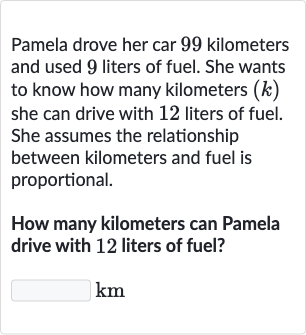AI tutor
Welcome to Bytelearn!
Let’s check out your problem:

Pamela drove her car kilometers and used liters of fuel. She wants to know how many kilometers she can drive with liters of fuel. She assumes the relationship between kilometers and fuel is proportional.How many kilometers can Pamela drive with liters of fuel?
Full solution
Q. Pamela drove her car kilometers and used liters of fuel. She wants to know how many kilometers she can drive with liters of fuel. She assumes the relationship between kilometers and fuel is proportional.How many kilometers can Pamela drive with liters of fuel?
- Establish values and relationship: Establish the known values and the relationship between kilometers and fuel.Pamela drove kilometers using liters of fuel. We assume a proportional relationship between kilometers driven and liters of fuel used.
- Set up proportion: Set up the proportion to find out how many kilometers Pamela can drive with liters of fuel.The proportion is based on the known values: km for liters is equal to km for liters.So, we write the proportion as .
- Cross-multiply for : Cross-multiply to find the value of .
- Solve for : Solve for by dividing both sides of the equation by .
More problems from Solve proportions: word problems
QuestionGet tutor help
QuestionGet tutor help
QuestionGet tutor help
QuestionGet tutor help
QuestionGet tutor help
QuestionGet tutor help
QuestionGet tutor help
QuestionGet tutor help
